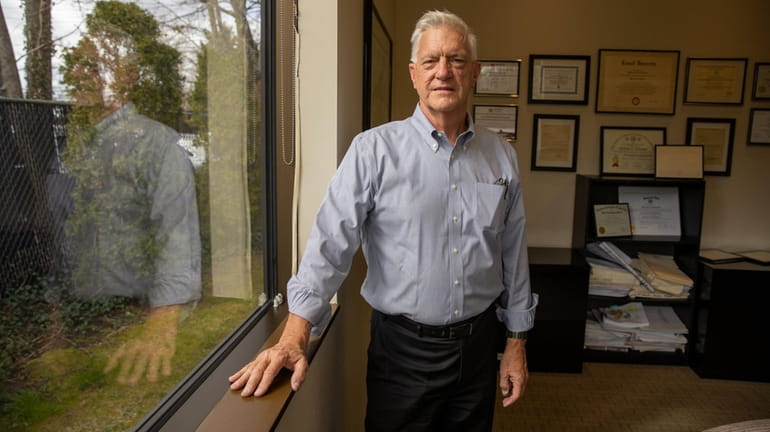Earthquake: What to doublecheck on your house

The requirements for seismic protection in New York are less onerous than those of states like Alaska and California, said professional engineer William Schlumpf. Credit: Morgan Campbell
Civil engineer Joseph Schmitt was driving when the East Coast quaked on Friday morning. He did not feel the shaking; but his wife, at their home in Stony Brook, did.
The magnitude 4.8 earthquake that rumbled across Long Island had its epicenter near Whitehouse Station, New Jersey, U.S. Geological Survey officials said Friday. It was followed by 32 aftershocks as of early Saturday evening, according to the USGS.
Schmitt, who founded the Long Island-based Schmitt Engineering firm in the 1970s, said Long Islanders need not be worried about earthquakes of this magnitude.
“If we’re designed adequately for the wind forces here, we’re most likely more than adequate for the earthquake loads that we would experience here,” Schmitt said.
WHAT TO WATCH
Experts give these tips:
- Do a visual inspection, also paying attention to smell.
- If you notice water leaking, or the smell of gas, contact a professional.
- Take note of cracks in the walls, or structural changes like windows that are suddenly hard to open and close.
- Consider inspecting the chimney, or calling in a professional.
Structures in New York State are built according to the American Society of Civil Engineers building code ASCE 7, Schmitt said. While the code does require consideration of seismic forces, concern about wind force on hurricane-prone Long Island is significantly greater, according to Schmitt.
Gas and water lines
By midday Saturday, home inspector Rob Byrne had received 8-10 calls from homeowners concerned about the effects of the earthquake.
“People are nervous,” said Byrne, of Higher Elevation Home Inspections LLC. And while Byrne takes those concerns seriously, he is not especially concerned that Friday’s quake would have caused structural damage.
In light of the governor’s warning to check gas and water lines, Byrne recommended homeowners start with a visual inspection — taking smell into account.
“It’s always good to be able to see what’s going on visually, and then back it up with sophisticated instrumentation,” Byrne said. “If you smell it, then you could figure out exactly how much gas is there by the detector.”
Take note of any water leaking. If necessary, a professional can use a moisture meter to test areas of concern.
Structural issues
For structural damage, Byrne made a similar recommendation.
“Look around your house, see if anything has changed since the earthquake,” Byrne said. “Do you see some cracking in your drywall, do you see some shifting?”
Signs of structural movement can include windows that are suddenly difficult to open and close, Byrne said.
Experts said structural damage to Long Island’s homes in the wake of Friday’s events was unlikely; and, Byrne noted, a structure determined compromised may have been that way before the earthquake. A home can have structural issues as a result of termite damage, improperly managed water intrusion, or deficient construction.
“I believe more so that the homeowners cause more structural damage to a house than the earthquake,” Byrne said.
Earthquake vibrations vs. hurricane force winds
An earthquake feels like a vibration, but the forces are typically stronger laterally than vertically, Schmitt said. Wind forces apply laterally, too, he said, and they can also generate an uplift load heavy enough to tear a roof off.
Since about the year 2000, Schmitt said, building code has required stronger resistance to wind loads, which would also increase resistance to seismic loads. Any structure built according to code after 2001, he said, should have extra reinforcement in the form of steel straps connecting roof rafters to wall studs, second-floor studs to first-floor studs, and the first floor to the foundation.
“That’s all now required, particularly on Long Island,” Schmitt said. “So that significantly improves earthquake resistance, as well.”
How do New York rules compare to earthquake-prone California, Alaska?
The requirements for seismic protection in New York are less onerous than those of states like Alaska and California, said professional engineer William Schlumpf, though they have increased over the years.
“They’re certainly adequate, and more than adequate for the type of event you saw [Friday],” said Schlumpf, the principal of West Islip-based Island Structures Engineering P.C.
Buildings constructed earlier than 2001 were built before additional wind resistance requirements — including Schmitt’s house, which was built in 1928 and has survived hurricanes since. But Schmitt is not necessarily concerned about these in an earthquake of this magnitude either.
“A wood-framed building still has a lot of flexibility, and the siding gives us a significant amount of rigidity, as well. So it can flex and move a bit, and get back to normal,” Schmitt said. “It might crack some things in a more severe earthquake.”
What are the most vulnerable structures?
The most vulnerable among Long Island’s structures in an earthquake, Schmitt said, would likely be one-story industrial warehouse buildings built decades ago of unreinforced masonry walls. With 14-to-16-foot-tall walls, these are “probably the weakest link” in an earthquake from a structural perspective, he said.
“Unless my house is built with unreinforced brick or concrete block walls, I wouldn't be concerned at all,” he said. “What we’re getting now is not enough to really even damage those.”
Byrne recommended checking on chimneys.
“Sometimes they can be affected a little bit more because they’re kind of freestanding," Byrne said. “To me, a chimney that’s kind of up high alongside of the house might be a little more susceptible to what happened than the whole house itself."
If the earthquake's epicenter was in NJ, why did we feel it on LI?
Despite little risk for damage in an earthquake of this magnitude, Schmitt said Long Islanders do often feel a quake more noticeably than those in parts of New Jersey or Manhattan that are built on bedrock.
“We’re on sedimentary soil, basically,” Schmitt said. “The force is actually magnified a little bit by the soft soil conditions.”
He compared this to San Francisco: Areas on landfill see more severe damage during an earthquake than the main part of the city does, he explained.
As for Long Island residents, Schlumpf, who has had training in seismic events and seismic building codes, said there is no reason for concern.
“I think they can sleep easy at night,” said Schlumpf, who has been a professional engineer for 45 years. “I know a lot about it, and I will.”

